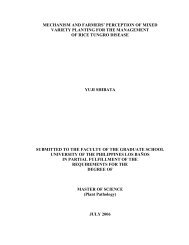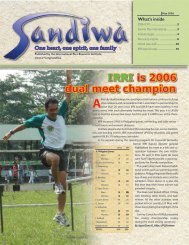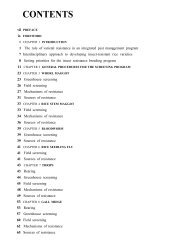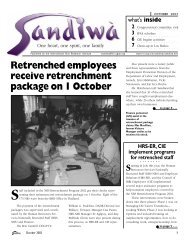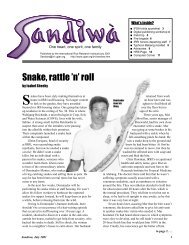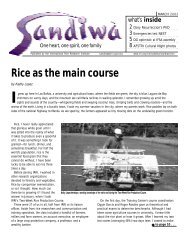Untitled - International Rice Research Institute
Untitled - International Rice Research Institute
Untitled - International Rice Research Institute
You also want an ePaper? Increase the reach of your titles
YUMPU automatically turns print PDFs into web optimized ePapers that Google loves.
a 4.90-cm diam in 5 d. They are evenly zonated,<br />
orange with white aerial mycelia that appear to be<br />
pressed to the media, and wet at the center. The<br />
colony on the reverse side of the agar plate is<br />
slightly zonated and orange to light orange outward.<br />
At 28 °C under alternating 12-h fluorescent light and<br />
12-h darkness, colonies grow moderately fast and<br />
attain a 5.0-cm diam in 5 d. They are orange without<br />
aerial mycelia. Colonies appear wet and slightly<br />
zonated with radial furrows and even margins. The<br />
colony on the reverse side of the agar plate is<br />
slightly zonated with radial wrinkles and orange,<br />
becoming light outward.<br />
Colonies on PSA at ART (28–30 °C) are thinly<br />
spreading, grow moderately fast, and attain a 4.87-<br />
cm diam in 5 d. They are azonated with even margins<br />
and light orange with scarce white aerial mycelia.<br />
White mycelial tufts are produced as colonies<br />
age. The colony on the reverse side of the agar<br />
plate appears azonated and light orange. At 21 °C<br />
under alternating 12-h NUV light and 12-h darkness,<br />
colonies are thinly spreading, grow moderately fast,<br />
and attain a 4.48-cm diam in 5 d. They are slightly<br />
zonated at the center, with even margins, and light<br />
orange with scarce white aerial mycelia that are<br />
pressed to the media. The colony on the reverse<br />
side of the agar plate is slightly zonated at the center<br />
and light orange. At 28 °C under alternating 12-h<br />
fluorescent light and 12-h darkness, colonies grow<br />
moderately fast and attain a 5.89-cm diam in 5 d.<br />
They are zonated at the center with about 1.5-cm<br />
submerged advancing mycelia and sinuate margins.<br />
Colonies are orange with white, densely floccose<br />
aerial mycelia. The colony on the reverse side of the<br />
agar plate appears zonated at the center and orange.<br />
Colonies on MEA at ART (28–30 °C) are thinly<br />
spreading, grow moderately fast, and attain a 4.93-<br />
cm diam in 5 d. They are zonated, with even margins,<br />
and orange with scarce white aerial mycelia<br />
that are somewhat pressed to the media. The colonies<br />
appear wet. The colony on the reverse side of<br />
the agar plate is zonated and orange, At 21 °C under<br />
alternating 12-h NUV light and 12-h darkness, colonies<br />
are thinly spreading, grow moderately fast, and<br />
attain a 5.67-cm diam in 5 d. They are zonated, with<br />
few radial furrows and even margins, and orange<br />
with scarce white aerial mycelia that are somewhat<br />
pressed to the media. The colonies appear wet at the<br />
center and spread outward with age. The colony on<br />
the reverse side of the agar plate appears zonated<br />
with few radial wrinkles and orange. At 28 °C under<br />
alternating 12-h fluorescent light and 12-h darkness,<br />
colonies are thinly spreading, grow fast, and attain a<br />
6.03-cm diam in 5 d. They are zonated with serrated<br />
margins, orange with scarce white aerial mycelia<br />
that are somewhat pressed to the media, especially at<br />
the center, and become wet with age. The colony on<br />
the reverse side of the agar plate appears zonated<br />
with few radial wrinkles and orange.<br />
Pyricularia oryzae Cav.<br />
syn. Pyricularia grisea (Cooke) Sacc.<br />
Pyricularia grisea<br />
Pyricularia oryzae Cavara<br />
Dactylaria oryzae (Cav.) Sawad<br />
Trichothecium griseum Cooke<br />
teleomorph: Magnaporthe grisea (Hebert) Barr<br />
Ceratospaeria grisea Hebert<br />
Phragmoporthe grisea (Hebert) Monod<br />
Disease caused: blast<br />
a. Symptoms<br />
The fungus can infect rice plants at any growth<br />
stage although it is more frequent at the seedling<br />
and flowering stage.<br />
On the leaves—Initially, lesions appear as small<br />
whitish or grayish specks that eventually enlarge<br />
and become spindle-shaped necrotic spots with<br />
brown to reddish brown margins. The size, shape,<br />
and color of the spots vary depending upon the<br />
susceptibility of the variety and environmental<br />
conditions.<br />
On the panicle base—Infected tissue shrivels and<br />
turns black. It breaks easily at the neck and hangs<br />
down.<br />
On the nodes—Infected nodes rot and turn black.<br />
27



